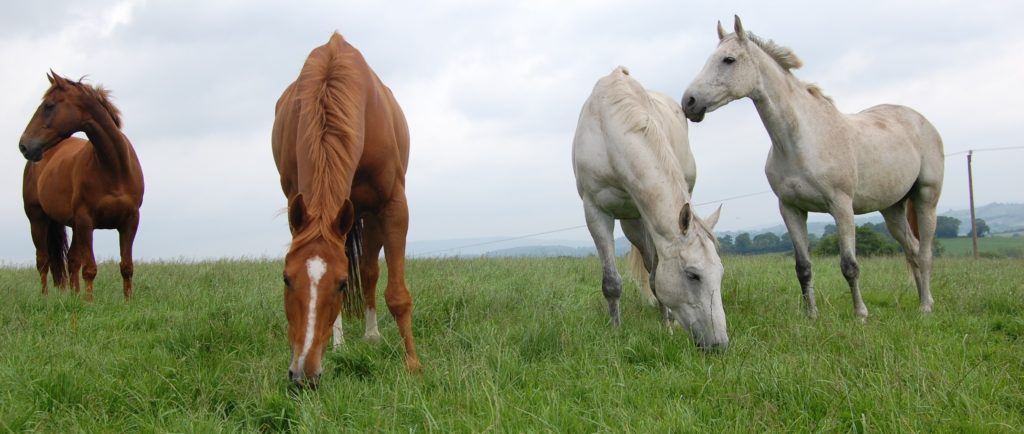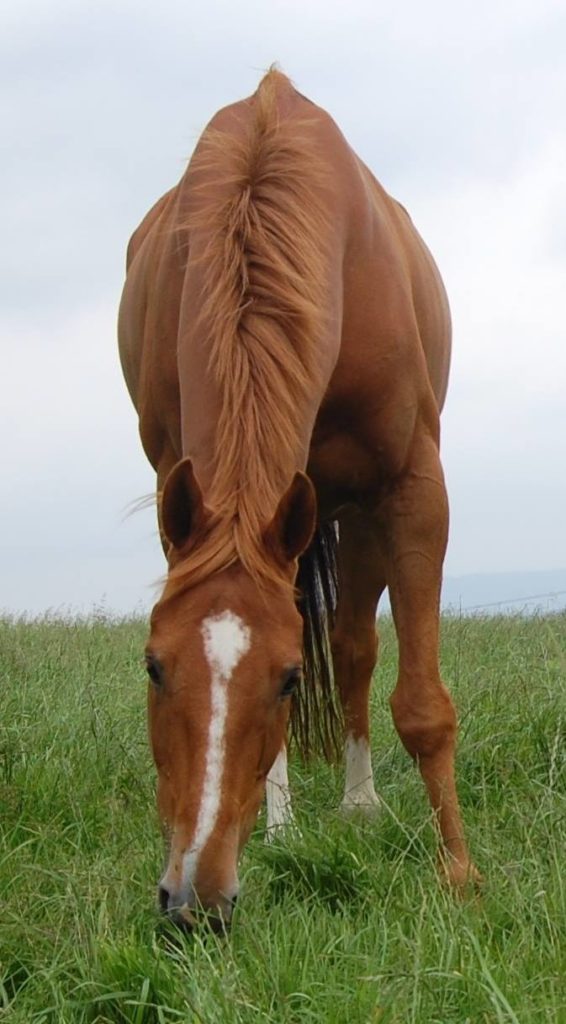Equine behaviour at grass
August 14, 2020
Rachel Annan, Equine Technologist, CAFRE
The horse is a herd animal whose digestive system has evolved to eat large amounts of low quality fibre throughout the day. Unrestricted feral horses have been seen to graze, for between 16-20 hours per day, (Duncan, 1987). This is where one of the golden rules of feeding horses “feed little and often” originated from, with the equine gastrointestinal tract being most healthy when it is continuously, partially full of fibre.
A number of scientific studies have observed the grazing patterns of horses and found that unrestricted horses will graze fairly continuously throughout the day, with a slight increase in consumption just after dawn and at dusk. However, horses who have limited turnout time at pasture have been seen to graze very intensely, consuming much more grass in a similar timeframe than their unrestricted counterparts. Night grazing occasionally occurs and is observed more in the summer months.

Horses can consume between 2 and 3% of their body weight in dry matter when turned out to pasture each day. In well-managed, high quality pasture, this potential amount of calories consumed is more than what the horse requires to maintain bodyweight. Although horses may continue to graze poor-quality pasture over a longer timeframe in order to meet nutritional requirements, horses on high-quality grass will continue to eat, for much longer than is necessary to simply meet nutritional requirements, often leading to issues with obesity. The amount of time spent grazing can be affected by factors like severe weather (either hot or cold) or an abundance of flies, and horses on their own tend to eat less than those with equine companionship. Young horses also seem to spend less time grazing than their adult counterparts.
A well grazed field will often see “lawns and roughs”, lawns being described as areas which have been intensely grazed where grass is eaten down to a very short length, while “rough” areas are normally used for toileting, where the horses tend not to eat. In these rough areas, the grass grows longer, and weeds may appear. Only if the pasture is very scarce will the horse eat these sections of the field, and this can have a significant impact on parasite burdens. Horses can deposit manure on pastures at an average rate of 18-22 kg per horse each day and removal of droppings from smaller fields is necessary to break the equine parasite life cycle.

In one study investigating grazing behaviour in horses, Odberg and Francis-Smith (1976) reported that lawns, roughs, and bare patched areas were created at 48%, 31%, and 21% of the total available grazing area, respectively. These figures would mean that less than half of a field is actually being used for feeding and this is where multi species grazing can be a valuable use of grass. If given enough space at pasture, the horse will urinate and defecate in these “rough” areas and then move away to another section of the field. Horses can defecate while they continue to graze but must stop to urinate as this requires muscle relaxation of the pelvis and hind legs.
Unlike cattle, horses will graze grass close to the ground biting it off between their upper and lower incisors. They also have the ability to browse, by picking the leafy material from bushes, trees, or other plants. If adequate pasture is available, these anatomical/behavioural combinations result in the ability of horses to be selective about what they consume. The horse will often select the most palatable part of the plant and leave the stems and undesirable portions. Hunger and lack of grass or forage will decrease selectivity.
If on unrestricted turnout, horses will spend between 5-10% of their time lying down, especially in the three to four hours before dawn. Horses and most grazing animals, sleep an average of two and a half to three hours every 24 hour period, if conditions are ideal and the environment is secure. This sleep will take place in short periods of roughly 15 minutes at a time. Equids (horses, asses, and zebras) are the only animals that can sleep standing up and it is thought that this has evolved as a way to remain alert for predators. When horses sleep standing up, they are in slow-wave sleep. Horses can rest standing up because they have modifications in their muscles, ligaments, and tendons that allow mechanical use, without any active effort or energy, to hold their joints in place.
Horses have four phases of sleep: diffuse drowsiness, intermediary, slow-wave, and paradoxical. The deepest phase which involves Rapid Eye Movement (REM) sleep is the paradoxical sleep stage and can only take place when the horse is lying down, in a recumbent position, on their side. Horses will only reach this phase when they feel completely at ease in their surroundings. Horses can be influenced to lie down for paradoxical sleep if they reside with other horses that lie down regularly. And if one horse is familiar in a particular environment, and lies down, others will often follow.
Bibliography
Bott, R., et al, 2013, Production and Environmental Implications of Equine Grazing, Journal of equine veterinary science. Duncan, P., 1887, Horses and Grasses. The Nutritional Ecology of Equids and Their Impact on the Camargue Horses and Grasses. The Nutritional Ecology of Equids and Their Impact on the Camargue
Odberg F.O. & Francis-Smit, K., 1976, A study on eliminative and grazing behaviour–the use of the field by captive horses. Equine Vet J, 8 (1976), pp. 147-149
Siciliano P. D., 2013, Estimation of pasture dry matter intake and its practical application in grazing management for horses.
